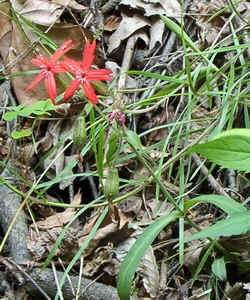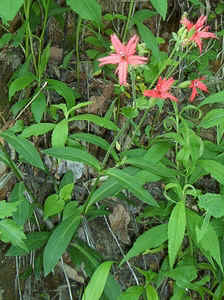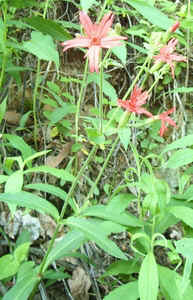 |
||
 |
 |
Common Name: Fire Pink or Indian Pink, Catchfly
Scientific Name: Silene virginica
Family: Caryophyllaceae
Pierson Fall's Road
Saluda, North Carolina
April 27, 2002
 |
||
 |
 |
The sticky stems of this native perennial have opposite leaves, are regularly branched, and are 1-2 feet tall. The showy flowers, with petals often deeply notched, are up to 2 inches across. Single plants or clumps of Fire pink are seen along roadsides at the edge of rich woods in the mountains and piedmont of North Carolina and over much of the eastern U.S. April-June [Justice, William S. and Bell, C. Ritchie, Wild Flowers of North Carolina. University of North Carolina Press, Chapel Hill, 1968]
One look and you'll ask, "who called this brilliant red flower pink?" "Pink" refers not to the color of the petals, but to their shape. Each of the five petals is pinked or notched at its tip. A loose cluster of star-shaped flowers sit atop a stem with pairs of slender opposite leaves. Sometimes this plant is known as "catchfly" because it has sticky hairs on its fused sepals. This tubular calyx protects the flower's nectar from crawling insects. The deep tubular corolla evolved to use flying insects and hummingbirds as its primary pollinators. These animals have a better chance of passing pollen to another flower than crawling insects, especially in this plant's harsh habitat where few plants grow very near each other. April-June [White, Peter, Wildflowers of the Smokies. Great Smoky Mountains Natural History Association, Gatlinburg, 1996]
January February March April May June July August September October November December
Alphabetical Listings -- A B C D, E F G H I, J, K L M N, O P Q, R S T U, V W X, Y, Z
Family Listings -- A B C D, E F G H I, J, K L M N, O P Q, R S T U, V W X, Y, Z
Genus Listings -- A B C D, E F G H I, J, K L M N, O P Q, R S T U, V W X, Y, Z